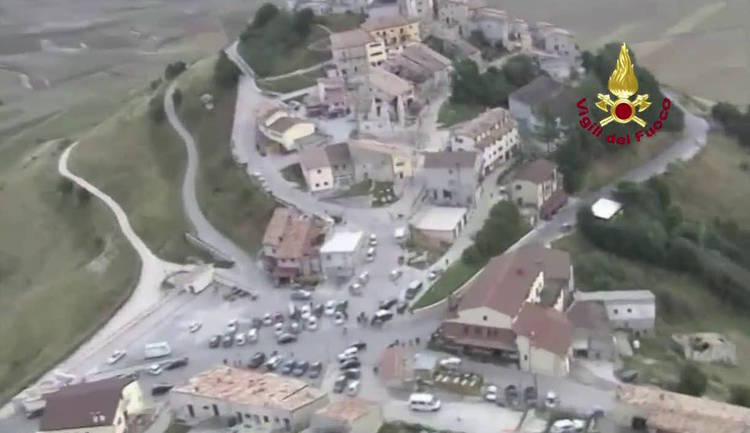


A 6.6-magnitude earthquake [2] jolted central Italy near Norcia [3] on Sunday morning, the country’s fourth quake in just over two months. The series began [4] in late August, killing nearly 300 people in the town of Amatrice [5], followed by a string of tremors [6] earlier last week near Visso [7].
The most powerful hit since 1980 [8], no deaths have been linked to the latest; however, according to CNN [9] it reportedly injured twenty people. Furthermore, the seismic activity toppled ancient buildings, leveling a historic basilica [10], and left thousands homeless, with more than 15,000 people being housed in temporary shelters.
Why did no one die in the last three earthquakes?
In terms of Wednesday’s tremors, NBC [11] credits three reasons to this remarkable phenomenon. Many houses were restructured after a 1997 earthquake [12] in the affected area; subsequently, fewer buildings collapsed. Of the houses that did, many were uninhibited as a result of widespread damage from two months ago. Third, once the first quake struck, many residents fled their houses, avoiding the stronger hit two hours later.
Similarly, in regard to Sunday’s devastation, the vicinity was largely empty following last week’s jolts, as many locals had been evacuated to shelters and hotels elsewhere or were sleeping in cars and makeshift tents. Still, the AP [13] reported that close to 8,000 people from the region had sought help from the civilian protection agency [14].
Why has Central Italy suffered so many earthquakes?
Central Italy is situated along an extremely seismically active mountain range known as the Apennine [14] “red belt,” and has a long history of severe earthquakes.
Prior to recent desolation, the last tremor of such great magnitude was less than a decade ago in 2009 in L’Aquila [15], which killed over 300 and displaced about 65,000. Another calamitous quake [16] took place in 1915, fatal for an estimated 32,000.
The region is at a particularly heightened risk of earthquakes due to the number of fault lines [17] that run directly underneath the area. United States Geological Society [18] (USGS) seismologist Gavin Hayes told CNN [9] that earthquakes only occur when energy accumulates along fault lines.
"These earthquakes don't represent any overall increase in tectonic activity, they're just clustered together because that's how earthquakes work," he said.
"Just think of it as an energy budget building up slowly over time and then being released fairly rapidly. Then the clock resets and then after a period of time another series of earthquakes will happen to release that energy."
For example, in 1783, five major earthquakes over 6.5 in magnitude struck Calabria over the course of two months, leaving more than 50,000 people dead.
Are there more to come?
Though earthquake prediction in general is effectively impossible, the recent quakes are indeed anticipated to be part of an ongoing sequence.
"It's very possible that there will be more, there will certainly be ongoing aftershocks over the comings weeks to possibly months," Hayes said.
Gianluca Valensise, a noted seismologist with Italy’s National Institute for Geophysics and Volcanology [19], told Reuters [20], “An earthquake measuring 6 or larger creates stresses that are redistributed across adjacent faults and can cause them to rupture." He continued, “This process can continue indefinitely, with one big quake weakening a sister fault in a domino process that can cover hundreds of kilometers.”
For information on how to donate, visit the Italian American Relief Fund [21].
Source URL: http://test.iitaly.org/magazine/focus/facts-stories/article/another-earthquake-rattles-central-italy-are-there-more-come
Links
[1] http://test.iitaly.org/files/castellucciodinorciajpg
[2] http://www.iitaly.org/magazine/focus/op-eds/article/after-quake-devastation-vows-reconstruct
[3] https://en.wikipedia.org/wiki/Norcia
[4] http://www.bbc.com/news/world-europe-37390893
[5] https://en.wikipedia.org/wiki/Amatrice
[6] http://www.ansa.it/english/news/2016/10/31/thousands-homeless-after-biggest-quake-since-1980-3_dcb5077c-adcc-4d7a-90eb-259b86e19f1b.html
[7] https://en.wikipedia.org/wiki/Visso
[8] https://en.wikipedia.org/wiki/1980_Irpinia_earthquake
[9] http://www.cnn.com/2016/10/31/europe/italy-earthquake-norcia-explainer/
[10] http://www.npr.org/sections/thetwo-way/2016/10/30/499955453/6-6-magnitude-earthquake-flattens-much-of-historic-basilica-in-central-italy
[11] http://www.nbcnews.com/news/world/italy-s-latest-earthquake-appears-not-have-been-deadly-why-n673706
[12] https://en.wikipedia.org/wiki/1997_Umbria_and_Marche_earthquake
[13] http://hosted.ap.org/dynamic/stories/E/EU_ITALY_QUAKE?SITE=AP&SECTION=HOME&TEMPLATE=DEFAULT
[14] http://www.protezionecivile.gov.it/jcms/it/home.wp
[15] https://en.wikipedia.org/wiki/2009_L%27Aquila_earthquake
[16] https://en.wikipedia.org/wiki/1915_Avezzano_earthquake
[17] https://en.wikipedia.org/wiki/Fault_(geology)
[18] https://www.usgs.gov
[19] http://www.ingv.it/en/
[20] http://www.reuters.com/article/us-italy-quake-scientist-idUSKBN12U0L3
[21] https://www.italianamericanrelief.org